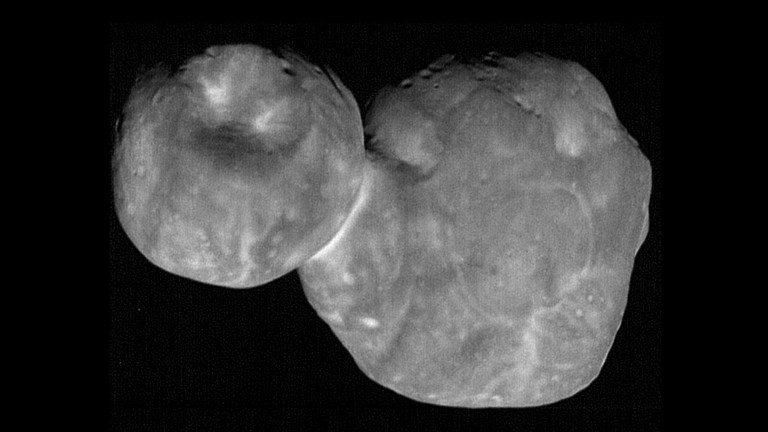
New Horizons mission scientists have released the first peer-reviewed results from their study of 2014 MU69, demonstrating just how “pristine” this object is.
(486958) 2014 MU69, nicknamed Ultima Thule, appears to be a pair of rocks squished together, each around 16km across. It orbits the Sun at a distance of around 6.5 billion km (Pluto orbits at around 5.9 billion km). It seems to have remained relatively unaltered from the solar system’s earliest era, and it already presented some surprises when the New Horizon spacecraft transmitted its first images back — and now, those first results are published and vetted. But things are just getting started for this team.
“It’s very early days,” Alan Stern, principal investigator of the New Horizons mission, told Gizmodo. “We’re just getting to the point where we can catch our breath.”
Astronomer Marc Buie discovered the pixel-wide MU69 using the Hubble Space Telescope in 2014, and New Horizons scientists set their spacecraft’s sights on the object after a successful campaign taking images of the dwarf planet Pluto.
The object is a cold classical Kuiper Belt object, meaning it orbits the Sun in a relatively circular, unperturbed orbit. Unperturbed is sort of the theme when it comes to this rock; the study’s authors call it “pristine”. Essentially, it’s like a time capsule from the beginning of the solar system that hasn’t been altered by the influence of the Sun or other planets.
New Horizons flew by the object and took detailed observations on 1 January 2019, and this week the mission’s scientists have unveiled their first published set of peer-reviewed results in the journal Science.
Their initial analysis revealed a few important things: First, the object is a bi-lobed contact binary, meaning it was two rocks that collided relatively slowly. Surprisingly, those rocks are flattened, not spherical.
Secondly, there’s no evidence of rings, satellites, dust, an atmosphere of gas, or any interaction with the solar wind.
Third, brightness and texture seem to vary across the object, with pits and lighter spots of bright material, but the composition itself doesn’t seem to vary.
These are just initial results, and the scientists will be downlinking data from New Horizons for at least another year. But researchers are already trying to understand MU69’s story. The object seems to have formed after two nearby homogeneous clouds of pebbles coalesced under the influence of gravity, and then slowly merged with one another.
Scientists who study planetary formation are excited by the idea of this pristine world. “We get to see something that’s more or less the way that it was at the end of planet formation, that formed where it is right now,” Christa Van Laerhoven, a postdoctoral fellow at the University of British Columbia who is not affiliated with the New Horizons team, told Gizmodo.
She explained that MU69 exists at a size that’s a little too big for electromagnetism to be the dominant force and a little too small for gravity’s effects to take over, meaning that it could provide more data to aid in the understanding of the planetary formation process.
And the object’s flattened shape is especially mysterious. “It’s a bit surprising that there’s something that flat in the outer solar system,” Kat Volk, associate staff scientist at the the University of Arizona who is not on the New Horizons team, told Gizmodo.
Physicists usually assume things in space are spherical, so it will take some thinking to understand how MU69 ended up looking the way that it does.
This is just one object, though, so we can’t generalise to the rest of the Kuiper Belt. “If we could just see more of them, that would be really great,” Volk said. “Especially in this size range that’s hard to see from the ground [on Earth].”
The New Horizons team hopes to continue studying Kuiper Belt objects and the intervening space, and might even plan a flyby of another object as the spacecraft continues its journey away from the Sun, said Stern. But before then, there are surely more mysteries just waiting to be found in the yet-to-be-downloaded data.





























